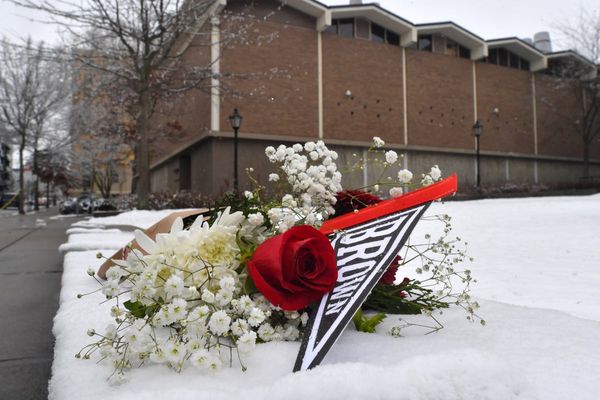
Silver-lined clouds hung over the Yup’ik village of Kwigillingok the Thursday before a weekend storm was forecast to pass through.
Dan Winkelman was at the community health clinic for a ground-breaking ceremony, a commemoration of the facility’s much needed expansion. The renovation – part of a $100m effort by the Yukon-Kuskokwim Health Corporation (YKHC) – was an example of the non-profit matching its money to its mission: to represent “the healthiest people” in south-western Alaska.
For the YKHC, this translated into about 30,000 Indigenous Alaskans belonging to 58 federally recognized tribes in the region. As president and CEO, Winkelman started that October weekend on a high note.
“I met with the council. I met with the community. We had a nice groundbreaking,” he said. “And then this storm happened.”
That storm, Typhoon Halong, pummeled as many as 15 villages across the Yukon-Kuskokwim (YK) delta, an expanse the size of Oregon and where the Yukon and Kuskokwim rivers meet the Bering Sea.
As Saturday turned to Sunday 11 October, hurricane-force winds unleashed towering waves that sent rivers and sloughs spilling over their banks. Kwigillingok saw record tides – above 6 ft. Kusilvak registered category 2 winds at 107mph (172.2km/h). Homes were swept away, power lines were downed, and fuel tanks spilled into winding wetlands.
One home that washed ashore belonged to 67-year-old Ella Mae Kashatok. Her body was recovered the next day, but her brother and son remain missing.
The disaster underscored the growing dangers in the YK delta: thawing permafrost, chronic erosion and increased flooding from storms that are becoming stronger and more frequent.
The region, one of six major climate impact zones in Alaska, sits atop fragile, sponge-like tundra prone to what the Yup’ik describe as vulnerable to usteq – catastrophic land collapse.
The substantial damage from Halong to so many Indigenous villages at once strikes at the heart of the delta’s ancient ties to these tundra lands. Murky floodwaters submerged berry-picking sites and hunting trails where valuable knowledge has been passed down for generations – the kind of lessons that aren’t taught in schools. It unearthed elders’ graves, a symbolic wound in a place where land and kinship are inseparable.
“We know this land,” said Tony Paul, 22, from neighboring Kipnuk, speaking from the school porch, one of few buildings the storm spared.
State emergency officials estimate about 90% of the village’s homes were destroyed, and half its boardwalks snapped like twigs, making Kipnuk the hardest hit. Power lines were down, and Paul joined a small crew determined to restore them.
“Some people want to come back,” he said. “They didn’t want to go.”
Almost all 700 residents were evacuated by military aircraft, and some were dramatically airlifted from their homes. Paul used his boat to rescue a few villagers, which is what may have spared it from the storm. He’s been looking for tools that had floated away and planned to search using the same boat he had used to rescue people. It had become the crew’s most valuable asset.
The Yukon-Kuskokwim delta has long faced a climate dilemma. Warming here is happening nearly four times faster than the global average, according to Noaa, drawing both attention and government funding.
But such recognition has also brought new strains and inflamed old ones, not least by the dismantling of climate programs by the Trump administration, and the still painstaking process for many villages to access much needed funds to defend themselves.
Two river villages, Newtok and Napakiak, each received $25m from the Bureau of Indian Affairs in 2022. Newtok completed the first full-scale climate migration in North America, last year, moving nine miles across the Ninglick River to Mertarvik. Napakiak’s move is ongoing and likely to cost hundreds of millions of dollars.
Yet such awards can be misleading.
“It is very difficult for these communities to get grants because they’re very competitive,” said Sheryl Musgrove, of the Alaska Institute for Justice or AIJ. “And these villages are subsistence-based villages. They don’t have a way to bring money in a lot of times.”
With the help of AIJ, Kipnuk secured its first-ever Environmental Protection Agency (EPA) grant – $20m to fight coastal erosion – but the Trump administration canceled it in May. A Biden-era disaster declaration also unlocked Fema funds, but tribal leaders say none have arrived.
As news about Halong started to circulate, and Kipnuk’s grant rescission made headlines, Lee Zeldin, the EPA administrator, turned to X, defending the cancellation.
“[Twenty]-million of hardworking US tax dollars are currently sitting in the US treasury instead of swept into the Kuskokwim River,” he said.
Musgrove noted he couldn’t even name the right river. The Indigenous village of Kipnuk borders the Kugkaktlik River, not the Kuskokwim.
“These villages are very, very poor,” she said. “They rely on assistance like EPA grants to get things done.”
At a press conference in Anchorage held over the weekend, Lisa Murkowski, an Alaska senator, quoted a Chinese proverb: “The best time to plant a tree is yesterday. The next best time is now.
“So, let’s get moving, now,” she said, a marked shift from three years earlier when, after Typhoon Merbok, she questioned whether Alaska should prepare for extreme weather at all.
After Halong, there was no such doubt. “It’s going to take resources and a combined effort,” Murkowski said. She praised Mike Dunleavy, the governor of Alaska, for requesting a federal disaster declaration from Donald Trump to activate Fema aid for as many as 50 coastal communities.
Lingering questions remain – will Kipnuk ever get rebuilt? If not, what will become of the community?
“This is what we have been dreading for years – decades,” said Rick Thoman, a climate scientist. “These northward-moving typhoons and what lies in its path: is that something we can expect more of? We don’t know. And Alaskans need to know.”
He emphasized one certainty: “We have to hope that the tribes are front and center in these conversations.”
Late last week, the last evacuees arrived in Anchorage by military plane with many taken to shelters established in the city. Outside at a downtown shelter, Lacey Paul, Kipnuk’s longtime school secretary, reunited with her auburn lap dog, Shiny, left behind during the flood. Her five-year-old daughter spoke to the dog in Yup’ik, filling the rainy night with laughter.
“Our dog is bilingual,” her mother said, holding Shiny close.
Perhaps it was that same comfort Winkelman sought as he flew his Super Cub over the storm-ravaged Delta days later. The land had begun to heal itself. Over time, his new mission was to help his people do the same.







